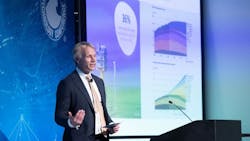OTC 2025: Fugro CEO says 'all the easy areas' are gone, need to move farther offshore
By Ariana Hurtado, Editor-in-Chief
At the Offshore Technology Conference (OTC), Fugro CEO Mark Heine led the "All of the Above Energy Mix" session on May 5 and was later joined on stage by Celine Gerson, Fugro's group director Americas, for a fireside chat.
Heine emphasized that a balanced energy mix is essential to meet varying demand and adapt to external factors.
In addition, electricity is becoming the dominant energy carrier, according to his presentation, and 36% of the world's final energy demand will be carried by electricity in 2050.
"The combination of solar and wind is really powerful and can deliver that growth [for electricity] for the upcoming decade," he added. "It will probably start to replace, step by step, some of the fossil fuels. This is already happening in Europe. You see that, in some countries, even gas is being replaced by offshore wind. So you see that this is changing quite rapidly, but still, every sort of energy is probably needed."
He also noted the exhaustion of "low-hanging fruit" and the need for additional geodata in new, deepwater areas.
"All the easy areas are taken by now," Heine said. "So for oil and gas development, as well as with the nearshore areas, the simple soil conditions where you can put the monopiles in very close to the shoreline that is now already used. So we need to realize that we have a problem with the complexity of projects. So the low-hanging fruit is gone, and we need to map deeper waters. We need to go farther offshore."
There is a growing need for geodata in offshore energy projects, including oil and gas, offshore wind, CCUS and hydrogen. Moreover, there will be a ninefold increase in demand for ocean space by 2050, and offshore wind is the key driver, according to Heine's presentation.
"A lot of people don't know, but only 25% of the whole oceans are mapped," he said. "There's a lot of ecosystems that we don't know about, so there's also demand for understanding the biodiversity [and] doing the environmental baseline studies."
He added that offshore wind is moving to challenging environments, and projects are getting bigger in size, especially in the North Sea where designated wind areas are farther offshore. He noted that turbines in 2013 used to be 6 MW and a "mind-boggling" 115 m, and now they are 14 MW from tip to tip and 236 m.
"The size is humongous," he said. "And then if you go to floating, you need even more data. You need to have current data. You need to have wave information. You need to have weather information farther offshore. So there are new complex issues [and] data issues to sort out."
Above all else, he proudly proclaimed that his big message is:
"For a sustainable future, we must stop coal, reduce oil, accept gas and accelerate renewables."
Which countries are leading in offshore wind?
Heine said there is already 80 GW of wind installed offshore, and the ambition to reach 250 GW in 2030 is "totally impossible" because "the capacity is simply not there."
He said China is the largest with 37 GW installed, and the UK has 16 GW. He also noted that "Germany is quite large."
Gerson added that with the right market conditions, there is a future for offshore wind in the Americas. Note, she identified the Americas as everything from Canada down to Argentina.
"Of course, we need an industry that can continuously adjust and adapt," she said. "We have changes from a supply chain cost perspective, regulatory changes [and] government changes."
As for the US, Gerson said 30 projects were paused, four of which are in the construction stage. "There will be some movement but certainly a slowdown" compared to the Biden administration that had promised 30 GW by 2030. She said that "a little bit more visibility and clarity around the executive orders" are needed.
Moving north, Canada is "definitely lagging" and "at the infancy," according to Gerson. The first auctions are due to take place at the end of this year or the beginning of next year. She added, "And they're promising online by 2030. I'm a little bit skeptical on this."
Then there are four countries taking the lead in Latin America: Brazil, Chile, Uruguay and Colombia. These countries are aiming for about 5 GW in 2030.
"Brazil announced their first set of regulation; they're working on it," Gerson said. "We need a little bit more definition and clarity. We're hoping that during COP 2030 in October that President Lula is going to announce a little bit more granularity around the regulations, but more importantly, the financing backbone. The developers need certainty around how they're going to bring power to market. They need to make sure that the regulations are clear so that they can have a good business case for the investments. We believe that the first lease is going to come out by the end of this year, beginning of next year."
Offshore Chile, it is "a very complex environment with lots of wind," she said, but its prone to earthquakes. Plus, the country is looking at floating wind, "which is even more complex," Gerson added.
Colombia "published the roadmap," according to Gerson, with eight companies pre-selected. However, she said a lot more needs to be done to provide clarity from a regulatory standpoint, and there are also some power and transmission challenges. She added, "But there is definitely a desire to move forward from the from the government."
Lastly, she explained that Uruguay is tying offshore wind to green hydrogen. "The challenge here is absolutely looking at the infrastructure and the cost of the green hydrogen infrastructure," she concluded.
Global offshore wind capacity
The countries with the most offshore wind capacity installed in 2023, according to a recent World Population Review report include:
- China: ~37.3 GW
- UK: ~14.7 GW
- Germany: ~8.4 GW
- Netherlands: ~4.0 GW
- Denmark: ~2.7 GW
- Belgium: ~2.3 GW
- Taiwan: ~1.6 GW
- South Korea: ~0.14 GW
- Japan: ~0.15 GW
- US: ~0.04 GW
About the Author
Ariana Hurtado
Editor-in-Chief
With more than a decade of copy editing, project management and journalism experience, Ariana Hurtado is a seasoned managing editor born and raised in the energy capital of the world—Houston, Texas. She currently serves as editor-in-chief of Offshore, overseeing the editorial team, its content and the brand's growth from a digital perspective.
Utilizing her editorial expertise, she manages digital media for the Offshore team. She also helps create and oversee new special industry reports and revolutionizes existing supplements, while also contributing content to Offshore's magazine, newsletters and website as a copy editor and writer.
Prior to her current role, she served as Offshore's editor and director of special reports from April 2022 to December 2024. Before joining Offshore, she served as senior managing editor of publications with Hart Energy. Prior to her nearly nine years with Hart, she worked on the copy desk as a news editor at the Houston Chronicle.
She graduated magna cum laude with a bachelor's degree in journalism from the University of Houston.

